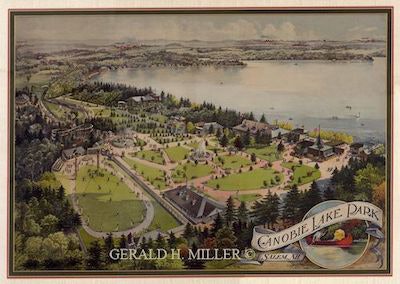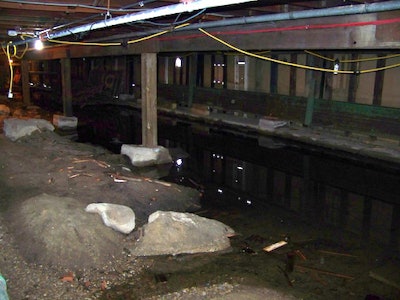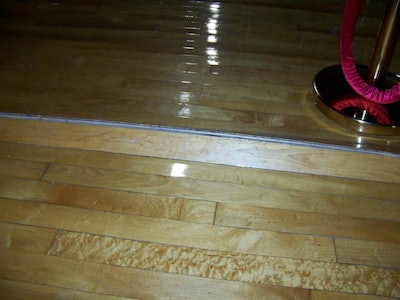
From 1969 until today it has been our family’s tradition to close the school year and start the summer with a trip to Canobie Lake Park, a circa-1902 amusement park in Salem, N.H. The park is conveniently located just up the road from our Derry, N.H., Wood Pro Inc. location, and beyond being a fun place to go, the park has become a very important wood flooring client for our customers.
I found out a few years ago that the park has over 15,000 square feet of vintage rock maple strip flooring as well as a fair amount of outdoor mahogany decking. In the spring of 2016, I first inspected 10,000-plus square feet of original maple flooring that was installed directly over large truss beams with absolutely no subfloor! During the spring runoff, there is enough water collecting to raise the lake under the facility containing the hardwood flooring (see the photo below). How has this floor survived almost 100 years? Because of the initial impeccable design-engineering and planning nearly a century gone ago.

Since the 1930s, Canobie’s Dancehall Theater, with its thousands of square feet of maple and fir flooring, was a popular hot spot for entertainers such as Guy Lombardo, Duke Ellington, Harry James, Jimmy Dorsey, Frank Sinatra, and later, Sonny & Cher and Aerosmith. It was in this theater where I had the honor of becoming involved. Its flooring was in need of renovation to improve performance, and this is where modern engineering collided with good old Yankee ingenuity. Nearly 10,000 square feet was almost lost to the scrap heap forever.
The front entry area of the Dancehall, roughly 4,000 square feet, has several double fire-door entries that open into an area approximately 20 by 75 feet containing maple strip hardwood flooring that had worn out from heavy foot traffic. A similar area at the back of the facility contains sections of fir flooring that was originally partitioned off and used as backstage dressing rooms and offstage wings.

As Canobie luck would have it, after the first 40 or so feet of flooring, there is a 7-inch step down the entire length of the dancehall. Thus, the buckling was contained within the entry area, saving the remaining 10,000-plus square feet. The flooring was repaired and weaved with original material saved from the carpet project, and the floors were sanded for the first time in ages. How much life is left in this floor? Just about none! Refinishers had to be cautious, as they could spot all the original flooring nails, which had been blinded for decades.

Today, Bona Traffic is used to maintain the flooring until the time comes it should be replaced. Replacement will take some modern-day engineering and planning since there is still an actual lake below portions of the facility. The floor looks beautiful thanks to C & L Flooring of Tyngsboro, Mass., and the park remains as vibrant and pristine as it has for decades.
In Part 2 of this blog we’ll look at the extensive decks that also had to be sanded at the park.































